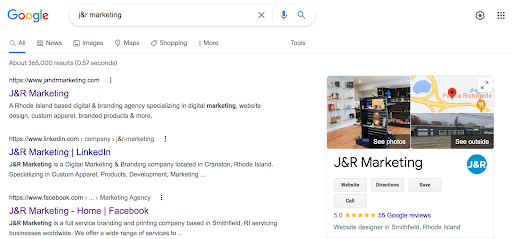Intro to SEO:
If you’ve ever worked with a marketing company, you’ve probably heard the term SEO thrown around. SEO stands for “Search Engine Optimization” and the end goal is to drive more visitors to your website. To anyone not deep in the digital marketing world, SEO can come off as complicated. SEO is complicated if you try to take it all in at once, but we’re here to explain the SEO basics for you.
SEO Basics:
SEO, or “Search Engine Optimization” is the process of optimizing your website so it ranks higher on search engines. That sentence alone may be a lot to take in, so I’m going to break down some of the terminology.
A search engine is what you use to look things up. Google, Bing, and DuckDuckGo are all examples of search engines.
When you type your search into any search engine, it takes your query, picks out keywords/phrases, and tries to match what you searched with a website or web page on the internet.
Your rank is which position you show up in for any given keyword AFTER paid ads. For example, if you search J&R Marketing, jandrmarketing.com appears in the first position, meaning we’re rank 1 for that keyword.
Rankings can fluctuate due to a variety of factors, including the geographic location of the person searching and the algorithm that the search engine is using to search. More on that later. Results may also vary across search engines, as they use different algorithms to process queries. If they’re doing their job properly, you should rank similarly (within a position or two) on all search engines.
Optimization is exactly what it sounds like. You need to optimize the content on your site to have your keywords, easily readable text, and good site speed. We’ll touch more on how to optimize your site in more detail later, but know that it’s a big part of ranking.
Search engines “crawl” your site, which means they go through each page and index the information on it. When you make changes to your site, search engines re-crawl the site.
Your main goal when starting to SEO your website is to rank your website on the first page of search engines by optimizing your site’s content to contain a predefined number of keywords. Now we’re going to dive into more advanced SEO practices for those that are looking to seriously begin optimizing their site.
Intermediate SEO:
There are two ways you can SEO a site: on-site and off-site. On-site SEO is the optimization we talked about previously. Off-site is things like pages that include text relating to your keywords and a link back to your website. These can also take the form of blogs other people write about you. Both on and off site SEO work in tandem to increase the rank of your site.
On-site:
There are dozens of factors that can improve or hurt your website’s SEO. I’m going to break them down into three sections: content, site speed, and URLs.
Content:
The content on your site plays a major role in how search engines rank your content. When a search engine crawls your site, it reads the text on the page and the code behind it.
First and foremost, you want to have a keyword or two you’re looking to optimize the content on the page for. You want to include that keyword on your page frequently, but be careful not to “stuff”, or carelessly add keywords. Search engines prefer to see a keyword density between 1% and 3%. This means for every 100 words on the page, you need to mention the keyword 1-3 times.
Search engines also prefer to see at least 500 words on the page. Ideally your content should exceed 500 words. That means using your keyword 5-15 times on the page. The content should feel natural to read, so if you end up not hitting that 500 word mark, make sure you don’t start adding random, unnatural stuffing to boost your word count.
You can also sneak a few keywords into your code or image names if you play your cards right. Giving images alt tags in the code also gets picked up by search engines. An alt tag is read out when you have your browser in screen reader mode. It is meant to help your reader understand an image if they can’t see it, so including keywords can be beneficial for both reasons.
Site Speed:
If you had two identical sites with EXACTLY the same content but one site ran faster than the other, the faster one would rank higher. Search engines want sites to be fast because humans prefer faster sites. Improving your site speed will also decrease the risk of a user leaving (or bouncing) because the page won’t load. You’re more likely to retain your visitors.
URLs:
Your website URLs are a small (but necessary) portion for SEO. Having keywords in your URL helps you rank that page for certain words or phrases. For example: jandrmarketing.com/website-design. This URL describes what the page is and gives us a few extra keyword mentions.
If you’re looking for more advanced information on SEO or a consultation specific to your brand, reach out to us at our website or call us at (401) 326-2932.






